Turmeric Milk or Golden Milk, call it what you will, is an Indian drink that has gained popularity in the western world in the last decade or so. In India, many consume this creamy and comforting drink at bedtime, and not just when they are unwell. Sometimes, a sweetened version is also given to kids to help them sleep better. In this post I share how to make turmeric milk (Haldi doodh), the traditional Indian way.
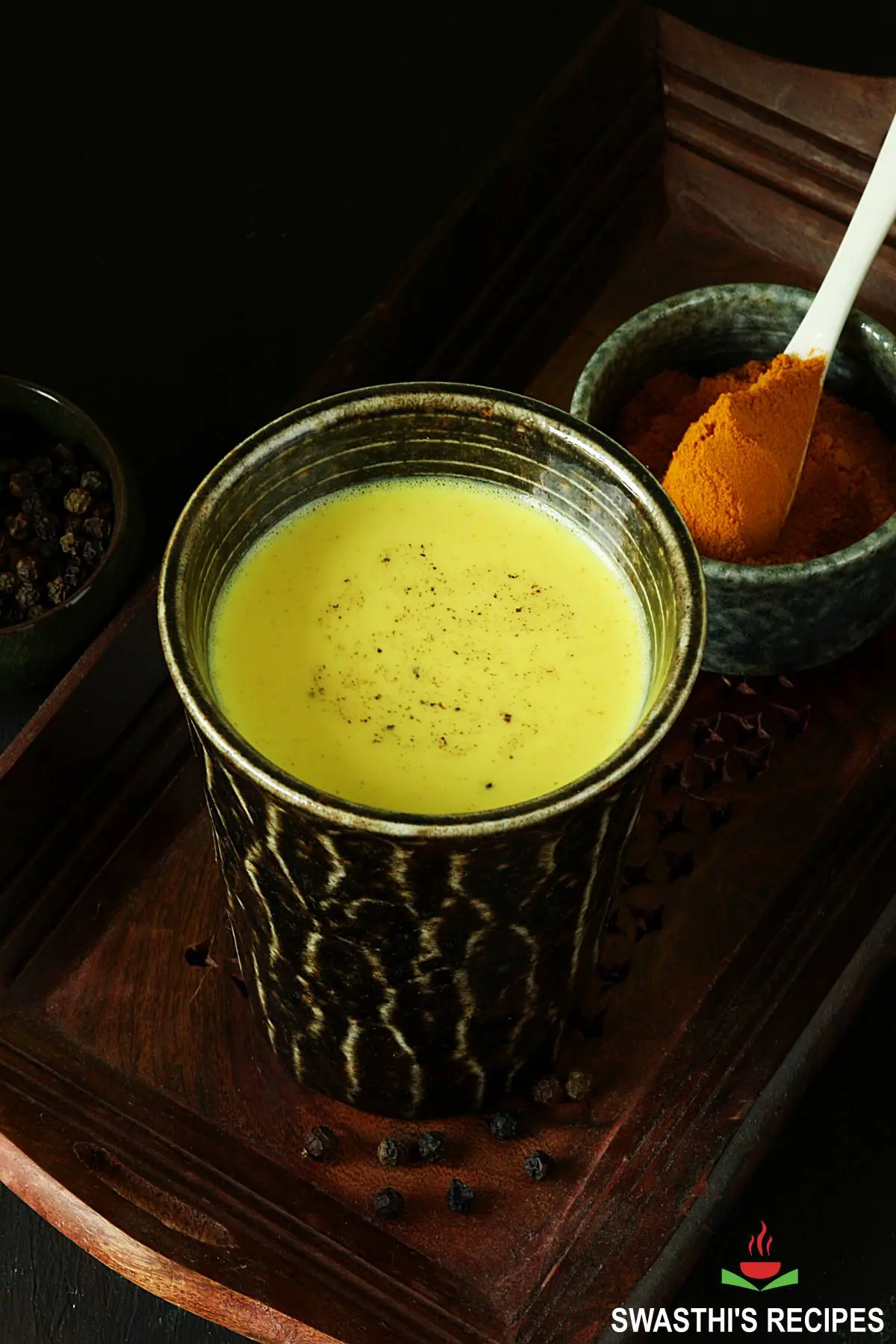
About Turmeric Milk
Turmeric Milk is a traditional Indian beverage made by mixing turmeric root and crushed long pepper known as pipli into hot or warm full fat milk. Also known as Haldi doodh, it is an age old ayurvedic remedy used to treat cold, congestion, cough, wounds, and other ailments.
The main compound in turmeric is curcumin. Piperine, the compound found in long pepper was believed to enhance the bioavailability of curcumin in turmeric. Traditionally fresh turmeric root is used to make haldi doodh. Nowadays people prefer to add powdered turmeric (made from the dried root) and black pepper powder instead.
Sometimes other medicinal spices like cinnamon, nutmeg or ginger are added to the milk. Some prefer it sweetened with a bit of honey or jaggery. It is often served only with the goodness of pure turmeric powder or grated fresh turmeric root.
Golden milk is a warm tonic with spicy undertones meant to nourish, protect and has a pleasant taste. While many of us shared a love-hate relationship with this drink as kids. We have an acquired taste for it as adults.
Across the globe, health aficionados and people looking for alternative and natural remedies have begun adopting this milk drink. A form of cold and unsweetened turmeric tea is now consumed in Okinawa, Japan famous for its healthy and centenarian inhabitants.
Creative versions are turning up everywhere and some are far removed from the original turmeric milk tonic. You’ll find apple juice used instead of milk with ghee added in for good measure.
Someone in the US has even created a Indian meets Chinese health drink using turmeric and pepper powder along with goji berries and coconut butter in milk. Of course, you will find a dozen vegan and paleo variety of the classic haldi ka doodh with medicinal spices of choice.
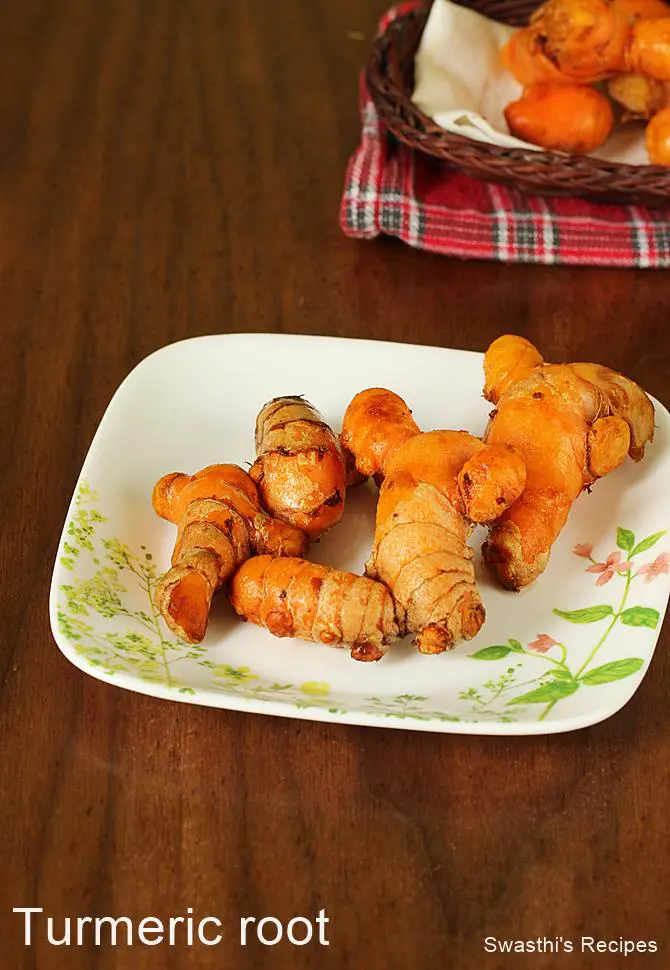
Why is Turmeric Milk special for Indians?
Turmeric has been used as medicine in India for over 5000 years. Archeological digs in Delhi found pots with traces of ginger, turmeric and garlic dating back to 2500 BC. From 500 BC, turmeric became an important medicinal plant under Ayurveda traditions. Burning turmeric and inhaling the fumes was considered beneficial for congestion and respiratory illnesses.
Ayurveda places high emphasis on both Sattvic – pure and simple foods and Ojas – vitality enhancing foods. Turmeric milk is considered to build and enhance this essential energy for a healthy body and mind.
Somewhere along the way, turmeric become an ingredient with spiritual and ritualistic value In Indian culture, and a popular culinary spice among savvy home cooks.
Even modern food scientists recommended warm milk as a comforting and sleep-inducing bedtime beverage. Haldi doodh takes this concept further with the addition of turmeric and medicinal foods.
Turmeric milk is simply one of the many ways Indians have included ayurvedic practices in everyday life, even thousands of years later. Turmeric, pepper, ginger and other healing spices and herbs are added to create a healthier diet and as proven home remedies.
Given the numerous health benefits, golden milk has been a part of our childhood regime against colds and congestions, especially in winters.
Health Benefits of Turmeric Milk
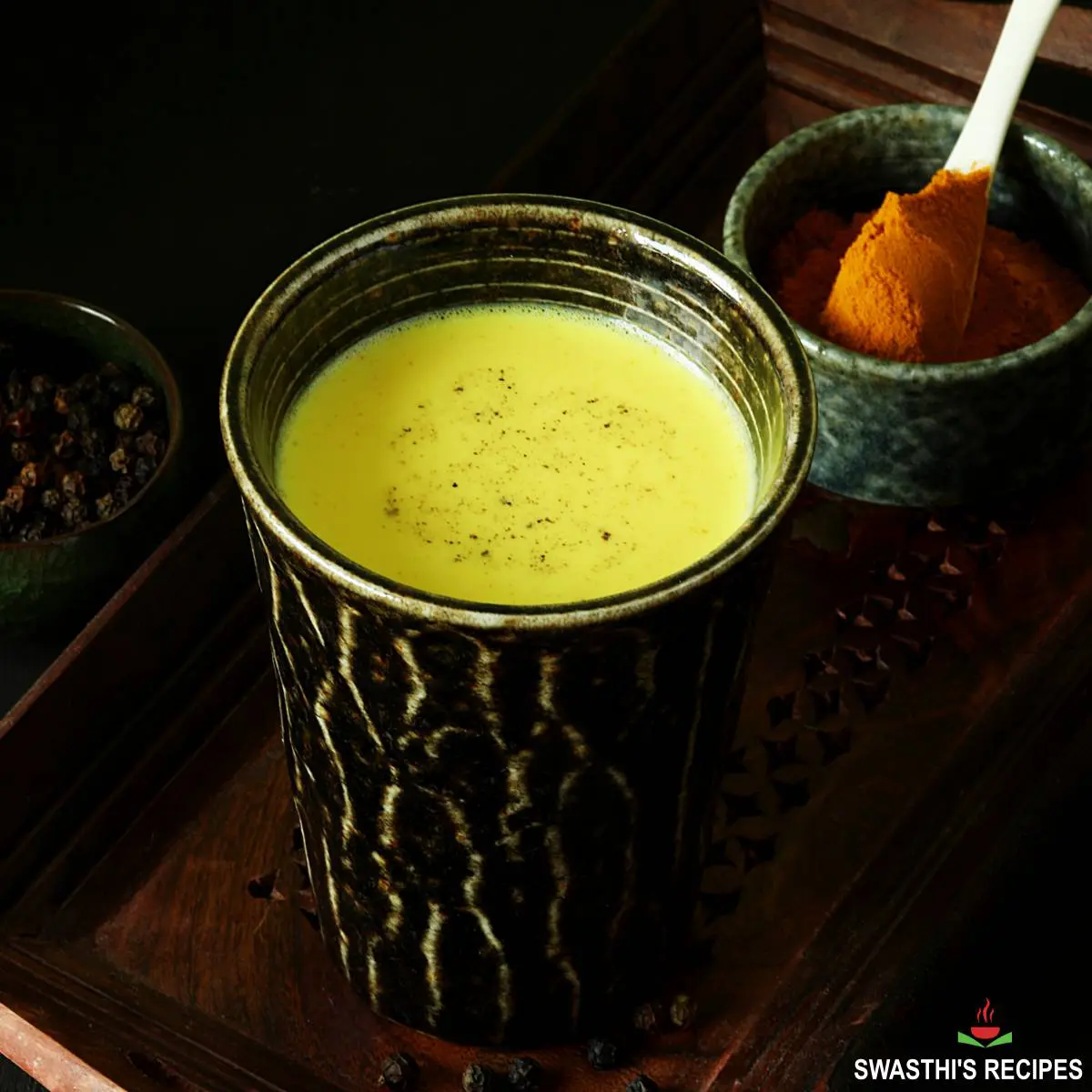
You know that traditional Indian medicine, Ayurveda, considers turmeric Jayanti or victorious medicine. Turmeric (Haridra in Sanskrit) is a rhizome that is considered to be Tridoshic and is said to balance the doshas (disturbances) in the body.
The scientific world has recognized and accepted the importance of turmeric, particularly its main compound curcumin, as a healing agent.
Nearly 3000 documented studies indicate that turmeric is not your average culinary spice. It is a powerful antioxidant, antibacterial and antifungal ingredient that can be added to cooked food and beverages.
From a stronger immune system, healthier heart and brain to improved digestion and gut health, the health advantages are numerous. You also get protected from diseases that are caused by long-term inflammation.
Turmeric can also detoxify the body, improve oral health, and enhance your mood.
When you combine it with calcium-rich and vitamin D enhanced milk, and other healing spices, you get additional health benefits. This is essentially important if you have growing kids at home.
But with any spice or herb, moderation is the key. Too much of turmeric taken internally can lead to diarrhea, rashes, dehydration, acidity, constipation, hair loss, problems during pregnancy, and even, liver disorders.
Always seek a medical expert’s advice before you consume turmeric (in capsule form) for treating ailments.
About this Recipe
There are numerous ways to make the soothing and frothy haldi ka doodh – plain, spiced, sweetened, not to mention, the increasingly cherished lattes and turmeric chai. My recipe is very simple. It contains only 3 ingredients and is easy to make. Add healing spices like turmeric and pepper powder to warm whole milk (not very hot). Stir well and you’re good to go!
Why is whole milk used?
Turmeric is added to full fat (whole) milk to avoid dehydration because milk has a high hydration index. Indians consider turmeric milk to be safe for kids and toddlers too. This is presuming your kid don’t have any allergic reaction to haldi.
You can have this golden yellow-colored nourishing drink anytime you need an immunity booster or seek to brighten your mood. Serve it to kids and adults when they show symptoms of cold, cough or congestion.
So, let us get down to makes us some wholesome haldi doodh.
You may like
Turmeric Latte
Pomegranate Molasses
Turmeric Tea
Badam Milk
Masala Chai
How to make Turmeric Milk (Stepwise photos)
1. Bring milk to a boil. In India many people use raw milk, so the milk is boiled first. Though I don’t use raw milk, I prefer to heat the it as we believe boiled milk is easy for digestion.
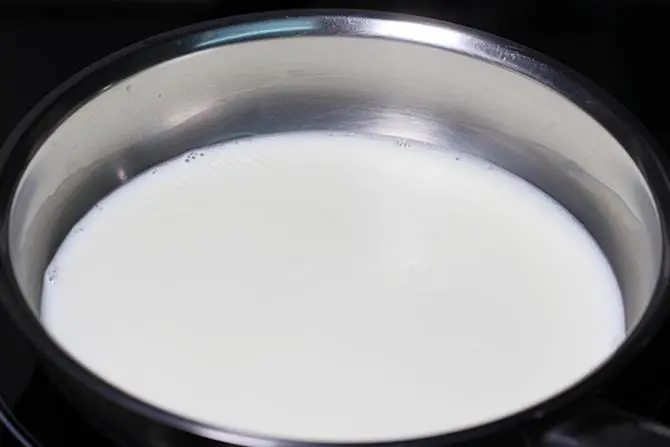
2. Allow the milk to cool down a bit. When the milk is slightly hot, add black pepper powder and turmeric powder or turmeric paste made from fresh root. My kids drink unsweetened milk, so I do not add any sweetener.
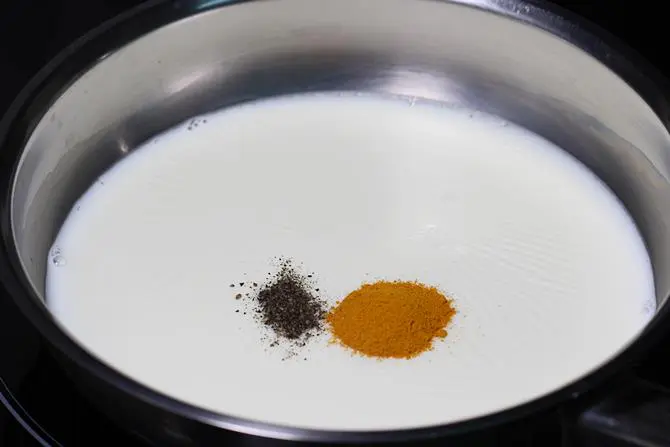
3. Stir well until the turmeric blends well with milk. Mix well with a spoon and transfer to a cup. I do not filter the cream or pepper, if you prefer you can strain the milk.
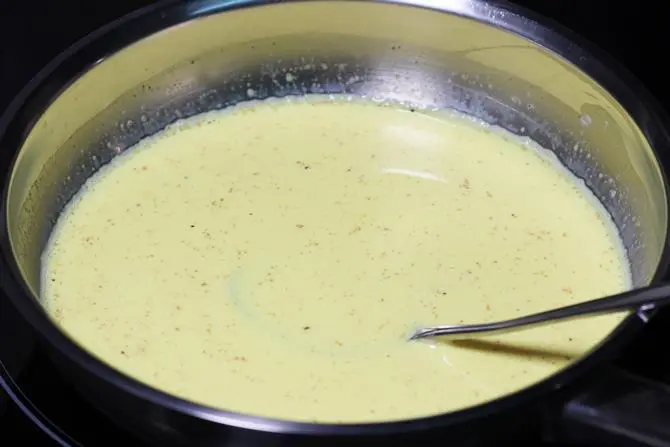
It is best to consume turmeric milk when it is warm preferably at bed time.
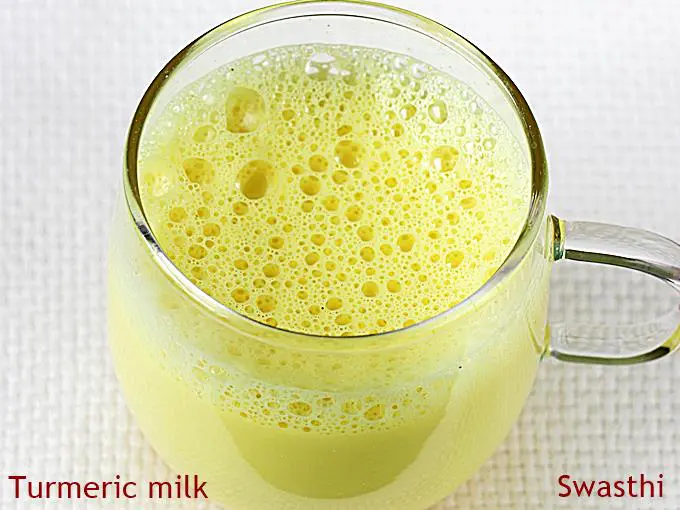
Pro Tips
- Always use organic turmeric powder or turmeric root and avoid chemically treated roots which are worse for our body.
- Fresh turmeric root is more effective than ground powder. But finding a organic fresh root is hard. If you are able to source it you can freeze it and use as and when needed within 3 months.
- You can grate the root and add it to hot milk and let it steep for a while. Then consume it. You can also filter it.
- To use the dried root, rinse it thoroughly. You can grate it and use or alternately rub it against a flat stone with few drops of clean water.
- Special flat stone tables are available which are used for rubbing sandal wood and turmeric root. You will get a smooth paste after rubbing the root for 5 to 7 minutes.
Faqs
Is golden milk the same as turmeric latte?
The classic haldi doodh or golden milk (made with regular or plant milk) is more of an immunity boosting drink. The turmeric latte that you find in Starbucks and other trendy cafes is a different beast. This sweetened concoction of frothy turmeric milk is poured over a shot of espresso.
While turmeric latte is a welcome change from sugary drinks, choose the simple golden milk to reap the nutritional rewards derived from milk, turmeric and added spices.
Can I add more spices to my turmeric milk?
Traditionally turmeric milk is made with just milk, turmeric and black pepper. But a lot of people also add many other crushed spices for flavor or for more suitability. Depending on your body condition you may use them. Here are some spices I have tried and tested with:
1 crushed Green Cardamom (or 2 to 3 pinches of ground cardamoms)
1 pinch of dried ginger (ground ginger)
1/4 inch piece cinnamon – 1/8 teaspoon ground cinnamon
1 clove (crushed)
Recipe Card
Optional Ingredients (Read notes)
How to Make Turmeric Milk
- In India, we believe that boiled milk digests easily so milk is always boiled before consumption.
- Turmeric milk works best when consumed warm. Consuming very hot turmeric milk can cause acidity.
- Traditionally turmeric milk is made with milk, turmeric and black pepper. No other ingredients are used. However for flavoring you may add the optional spices mentioned in the recipe but that is not the ayurvedic way. Every spice has a different effect on your body. Use cardamom for better digestion. Add cinnamon for its health benefits. Use clove and dried ginger for body warming properties.
- Also traditional Ayurvedic turmeric milk does not use sugar or any kind of sweetener. Use only if you can’t really drink without added sugar. If using honey, let the milk come down to warm temperature.
Alternative quantities provided in the recipe card are for 1x only, original recipe.
For best results follow my detailed step-by-step photo instructions and tips above the recipe card.
Nutrition Facts
Turmeric Milk Recipe (Haldi Doodh)
Amount Per Serving
Calories 157
Calories from Fat 72
% Daily Value*
Fat 8g12%
Saturated Fat 4g25%
Cholesterol 24mg8%
Sodium 105mg5%
Potassium 377mg11%
Carbohydrates 13g4%
Sugar 12g13%
Protein 7g14%
Vitamin A 395IU8%
Calcium 276mg28%
Iron 0.9mg5%
* Percent Daily Values are based on a 2000 calorie diet.
Disclaimer: This post is to provide information only and should not be considered for treatment or cure of any disease. Please see the doctor for appropriate treatment.
Turmeric milk recipe first published in September 2017. Updated and republished in Febraurary 2023.



